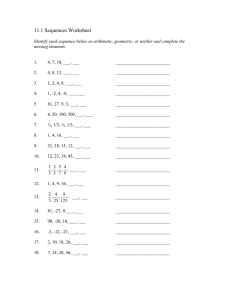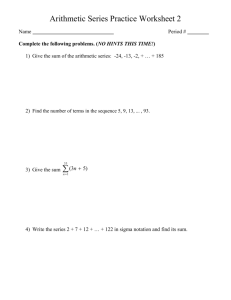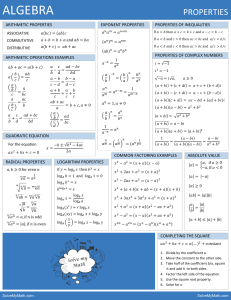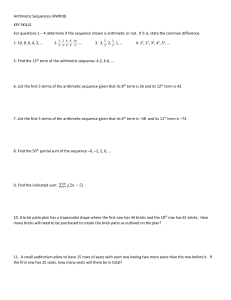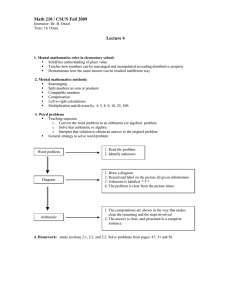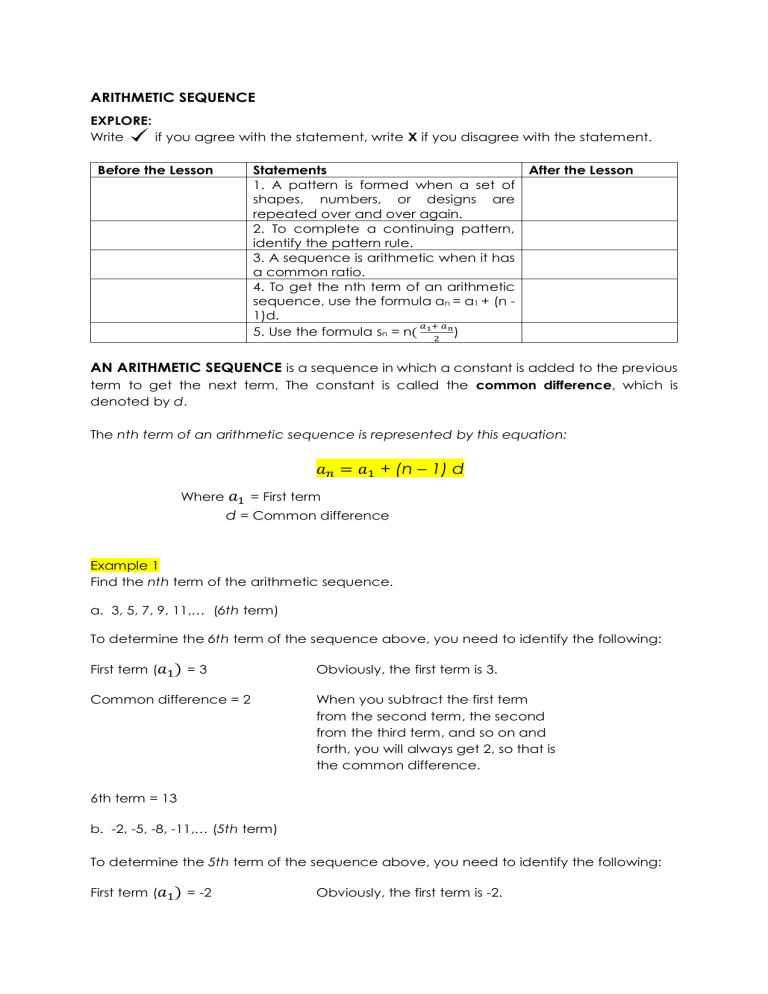
ARITHMETIC SEQUENCE EXPLORE: Write if you agree with the statement, write X if you disagree with the statement. Before the Lesson Statements After the Lesson 1. A pattern is formed when a set of shapes, numbers, or designs are repeated over and over again. 2. To complete a continuing pattern, identify the pattern rule. 3. A sequence is arithmetic when it has a common ratio. 4. To get the nth term of an arithmetic sequence, use the formula an = a1 + (n 1)d. 𝑎 +𝑎 5. Use the formula sn = n( 1 2 𝑛) AN ARITHMETIC SEQUENCE is a sequence in which a constant is added to the previous term to get the next term, The constant is called the common difference, which is denoted by d. The nth term of an arithmetic sequence is represented by this equation: 𝑎𝑛 = 𝑎1 + (n – 1) d Where 𝑎1 = First term d = Common difference Example 1 Find the nth term of the arithmetic sequence. a. 3, 5, 7, 9, 11,… (6th term) To determine the 6th term of the sequence above, you need to identify the following: First term (𝑎1 ) = 3 Obviously, the first term is 3. Common difference = 2 When you subtract the first term from the second term, the second from the third term, and so on and forth, you will always get 2, so that is the common difference. 6th term = 13 b. -2, -5, -8, -11,… (5th term) To determine the 5th term of the sequence above, you need to identify the following: First term (𝑎1 ) = -2 Obviously, the first term is -2. Common difference = -3 When you subtract the first term from the second term, the second from the third term, and so on and forth, you will always get -3, so that is the common difference. 5th term = -14 Example 2 Write a formula for the nth term of the given arithmetic sequence. a. 12, 17, 22, 27, 32,… b. 7, 4, 1, -2, -5,… Solution: a. Each term is 5 more than the previous term, so d = 5. Since 𝑎1 = 12 the nth term is 𝑎𝑛 𝑎𝑛 𝑎𝑛 𝑎𝑛 = 𝑎1 + (n – 1)d = 12+ (n – 1)5 Replace 𝑎1 by 12 and d by 5 = 12 + 5n – 5 Distributive Property = 5n + 7 Combine like terms Check: 𝑎1 𝑎2 𝑎3 = 5(1) + 7 = 12 Substitute a few terms = 5(2) + 7 = 17 = 5(3) + 7 = 22 b. d = -3 and 𝑎1 = 7 𝑎𝑛 𝑎𝑛 𝑎𝑛 𝑎𝑛 = 𝑎1 + (n – 1)d = 7+ (n – 1)-3 Replace 𝑎1 by 7 and d by -3 = 7 - 3n + 3 Distributive Property = -3n + 10 Combine like terms Check: 𝑎1 𝑎2 𝑎3 = -3(1) + 10 = 7 Substitute a few terms = -3(2) + 10 = 4 = -3(3) + 10 = 1 Example 3 Find the 15th term of the arithmetic sequence 4, 10, 16, 22, 28,… Solution: Note that 𝑎1 = 4 =, d = 10 -4 = 6, and n =15 𝑎𝑛 = 𝑎1 + (n – 1)d 𝑎15 = 4+ (15 – 1)6 Replace 𝑎1 by 4, d by 6, andn by 15 𝑎15 = 4 + (14)6 𝑎15 = 4 + 84 𝑎15 = 88 Distributive Property Simplify Add Example 4 In the arithmetic sequence 6, 12, 18, 24, 30,… , which term is 120? Solution: Find n when 𝑎𝑛 =120 Let 𝑎1 = 6, d = 6, and 𝑎𝑛 =120 = 𝑎1 + (n – 1)d 120 = 6+ (n – 1)6 120 = 6 + 6n - 6 120 = 6n n = 20 𝑎𝑛 Substitute the known quantities Distributive Property Combine like terms DPE Example 5 Find the 10th term of the arithmetic sequence while the first term is 13 and with the fifth term is 41. Solution: Find the common difference, d. Let 𝑎1 = 13, and 𝑎5 = 41 substitute to the formula 𝑎𝑛 = 𝑎1 + (n – 1)d. 𝑎5 = 𝑎1 + (n – 1)d 41 = 13 + (5 – 1)d Substitute the known quantities 41 = 13 + (4)d Simplify 28 = 4d SPE d=7 DPE Find 𝑎10 by substituting 𝑎1 = 13, and d = 7 𝑎10 𝑎10 𝑎10 𝑎10 = 13 + (10 – 1)7 = 13 + (9)7 = 13 + 63 = 76 Example 6 A conference hall has 10 rows of seats. The first row contains 10 seats, the second row contains 13 seats, the third row contains 16 seats, and so on. How many seats are in the last row? How many seats are there in the conference hall? Solution: a. Let 𝑎1 = 10, 𝑎2 = 13, 𝑎3 = 16, n = 10, d = 3 𝑎𝑛 = 𝑎1 + (n – 1)d 𝑎10 𝑎10 𝑎10 𝑎10 = 10 + (10 – 1)3 Substitute the known values = 10 + (9)3 Distributive property = 10 + 27 Simplify = 37 Add 37 seats in 10th row b. find the sum of 10, 13, 16,…, 37 10 + 13 + 16 + 19 + 22 + 25 + 28 + 31 + 34 + 37 = 235 There are 235 seats in the conference hall When many terms are to be added, more time and effort are needed. Let us use the shortcut to find the sum, Sn of any arithmetic sequence.




